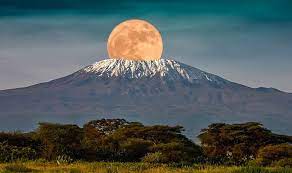Kilimanjaro: A Journey To The Roof Of Africa

Mount Kilimanjaro, located in Tanzania, is the tallest free-standing mountain in the world. It attracts adventurers and nature enthusiasts from all over the world. The mountain rises majestically to an altitude of 5,895 meters (19,341 feet) above sea level. Kilimanjaro is not just a geological wonder, but it is also a symbol of human resilience and determination. Embarking on a journey to conquer Kilimanjaro is a profound experience that goes beyond physical exertion. It is a quest for personal growth, cultural immersion, and breathtaking natural beauty.
Kilimanjaro is a stratovolcano situated in East Africa, formed by numerous eruptions that took place over millions of years. Its snow-capped summit is an iconic sight that can be seen from miles away, standing in contrast to the savannah plains that surround it. Kilimanjaro’s unique location near the equator allows for a diverse range of ecosystems to thrive on its slopes, including lush rainforests and alpine deserts. The mountain has three distinct volcanic cones, namely Kibo, Mawenzi, and Shira, each offering unique challenges and rewards to adventurous climbers.
Kilimanjaro is a mountain that has profound cultural significance for the people of Tanzania and beyond. It is known as the “Roof of Africa” and is revered by the indigenous Chagga and Maasai tribes. The mountain is deeply intertwined with local folklore, traditions, and spiritual beliefs. Visitors can explore the foothills of Kilimanjaro and discover the rich culture of Tanzania by immersing themselves in the local villages. Hospitable locals are eager to share their way of life, and visitors can gain insights into their traditions and beliefs. Climbing Kilimanjaro is not just about reaching the summit, it is also an opportunity to build connections with the people who call this land home.
Ascending Kilimanjaro is a true test of physical endurance, mental fortitude, and altitude acclimatization. Climbers must carefully prepare for the journey to the summit, as they navigate through various landscapes and unpredictable weather conditions. The climb presents different challenges at each stage, from the dense rainforests of the lower slopes to the barren lunar landscape near the summit. Climbers must be aware of altitude sickness, fatigue, and other factors that can hinder their ascent. Proper training, hydration, and pacing are essential for a successful climb. However, the rewards of summiting Kilimanjaro are unmatched. Standing atop Uhuru Peak, the highest point on the continent, offers a sense of exhilaration and accomplishment that words cannot adequately describe. The panoramic views of the surrounding plains and distant peaks, bathed in the golden light of dawn, are truly breathtaking. For many climbers, reaching the summit of Kilimanjaro represents a personal triumph and a testament to the human spirit’s capacity for perseverance and determination.
Mount Kilimanjaro is more than just a mountain. It is a symbol of human ambition, cultural heritage, and environmental stewardship. Climbing Kilimanjaro is a transformative journey that challenges the body, enriches the soul, and fosters a deep appreciation for the wonders of the natural world. Adventurers from around the world flock to its slopes in pursuit of their dreams. Kilimanjaro stands as a beacon of hope and inspiration, a testament to the enduring spirit of exploration and discovery.



